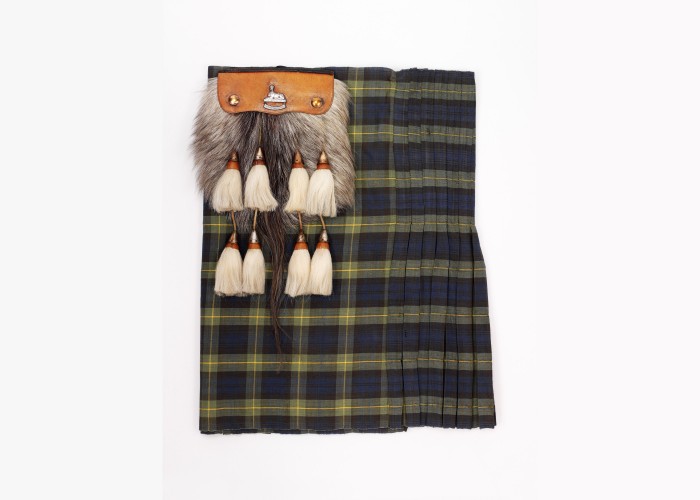Highland Regiment Kilt
This is the kilt and sporran (fur-lined pouch) of an officer who fought in the Gordon Highlanders (92nd Regiment of Foot) during the Waterloo Campaign. The Scottish Highland regiments, dressed in their traditional kilts and bonnets rather than the standard trousers and shako caps, were a major part of the Allied fighting force at the Battle of Waterloo.
There were three kilted regiments which served at Waterloo, the Black Watch (42nd Foot), the Cameron Highlanders (79th Foot) and the Gordon Highlanders (92nd Foot). This last regiment was raised in 1794 as the 100th Highlanders by the Duke of Gordon, but was re-numbered the 92nd Foot in 1798.
The kilt, an almost knee-length pleated skirt with a flat front (from an 18th century word, derived from the Scandinavian word kilte, to tuck up), was a strong mark of Scottish national identity. The original kilt was a large woollen belted plaid, wrapped and pinned around the lower body, with the upper part thrown over the left shoulder to keep the sword arm free. Various setts or tartan (from the Gaelic tarsuin) patterns were woven into the kilt wool. For example, the 79th Foot wore the Cameron of Erracht sett.
The later kilts worn at Waterloo were called the Feilidh beag, or little kilt. These had largely replaced the old, larger belted plaid by the 1790s. In action the kilt and sporran worn by officers were often changed for overalls (trousers), which were more suitable for riding. The tartan sett worn by the Gordon Highlanders was basically the Black Watch tartan, with a yellow stripe over the green bands. Dyes used at this time to colour the wool were vegetable in origin.
The sporran became a largely decorative article and was rarely worn on campaign by officers, pipers and men. Officer’s sporrans were more decorative than those of the other ranks, the latter being plain leather and animal fur, whilst the officers’ ‘purses’ had a silver or gilt upper clasp or decoration over a sealskin or badger fur-covered sporran. This example has two rows of tassels over a badger fur covered leather ‘purse’. The Sphinx motive of the regiment is clearly displayed, reflecting the service given to Sir Ralph Abercrombie’s expedition to Egypt in 1801. The battle honour “Waterloo”, added after 1815, is also visible on the front of the sporran.
This kilt and sporran belonged to Lieutenant John Bramwell, who served with the 92nd from 1813 – 17. He was severely wounded at the Battle of Quatre Bras, 2 days before Waterloo, and had his right leg amputated. He died after 1876.
In honour of the 92nd Foot, four privates of the battalion gave a dancing display, over four broadswords, at the Duchess of Richmond’s ball, which was held at the Rue de la Blanchisserie on the 15th June 1815.
-
Curatorial info
- Originating Museum: National Army Museum
- Accession Number: NAM. 1961-07-1
- Production Date: c. 1813
-
Use this image
You can download and use the high resolution image under a Creative Commons licence, for all non-commercial purposes, provided you attribute the copyright holder.
- Rights Holder: Copyright National Army Museum. Photography Relic Imaging Ltd.
- License Type: Creative Commons
Find it here
This object is in the collection of National Army Museum







